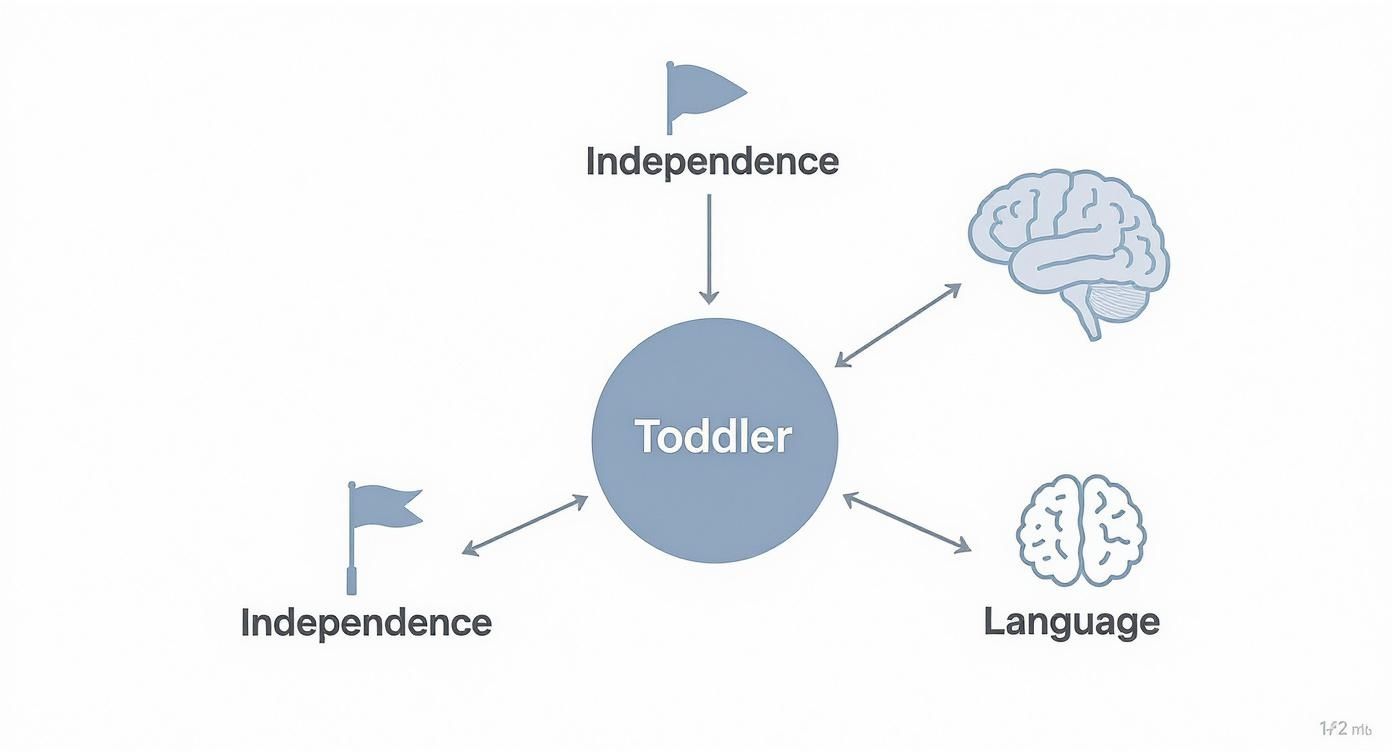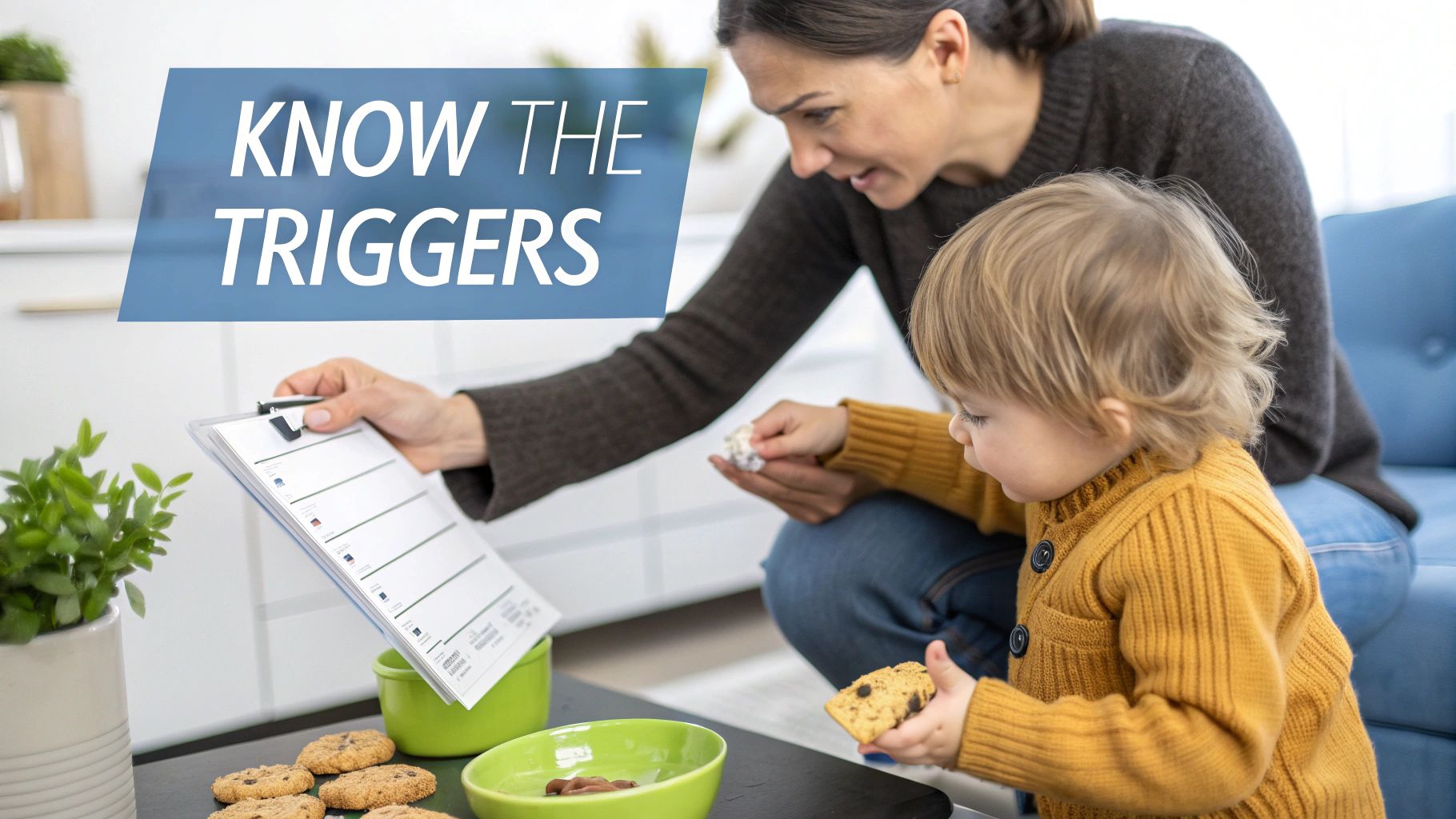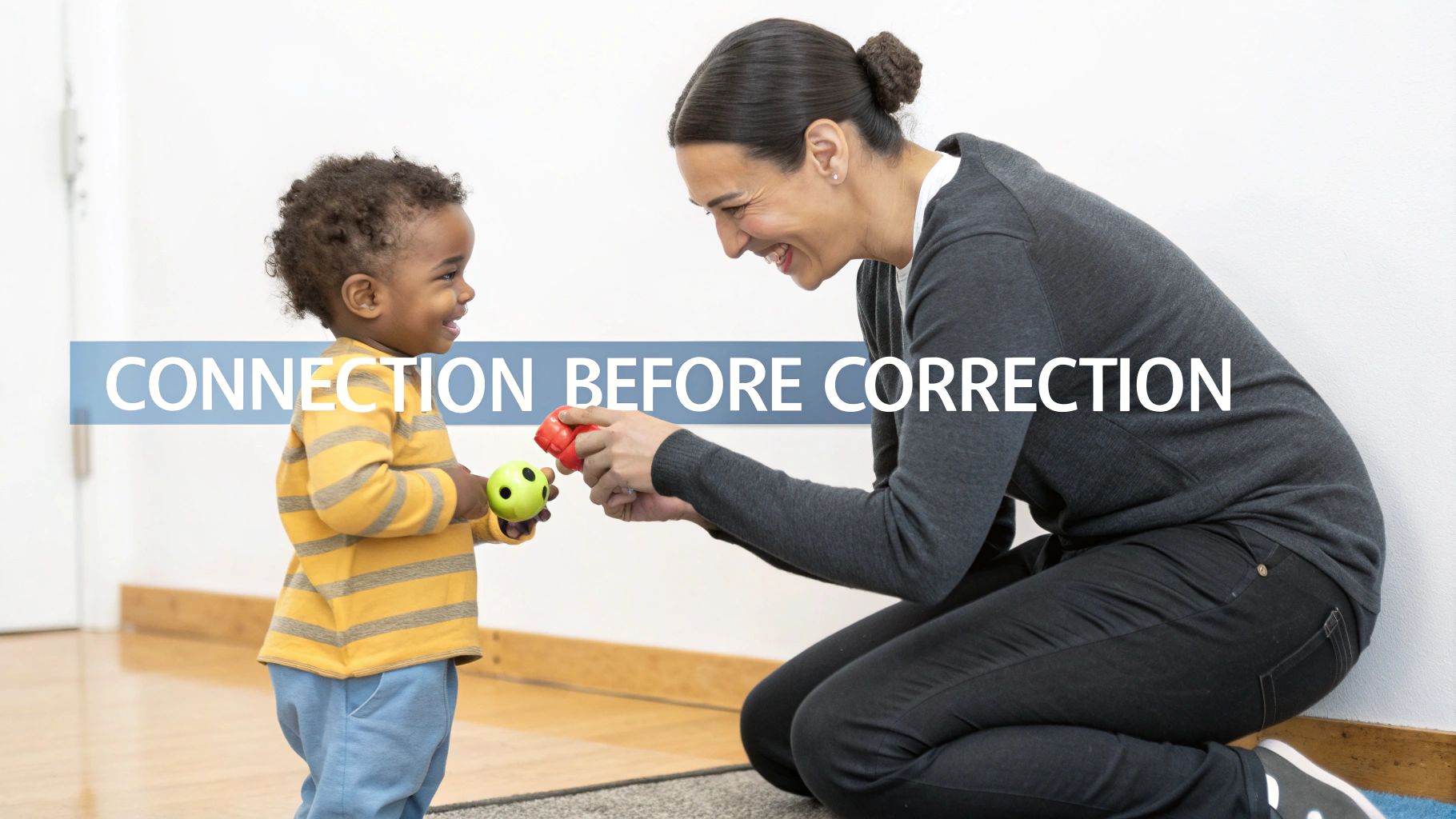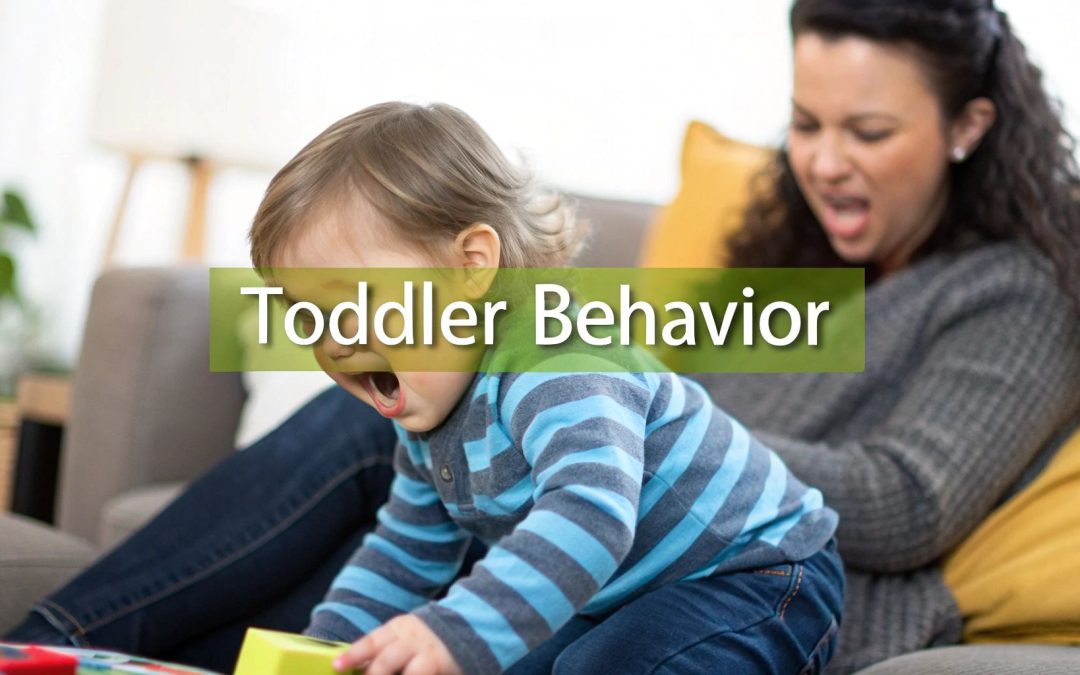If you've ever felt completely baffled by your toddler's defiant screams or their sudden, floor-thumping tantrums, you are absolutely not alone. These intense moments are a normal—and honestly, a necessary—part of their development. They're just trying to figure out a world of huge feelings with a brain that's still under construction.
Understanding the why behind these behaviors is your first and most powerful tool. It’s what helps you shift from feeling overwhelmed to responding with confidence and compassion.
Why Toddler Behavior Is So Challenging
Trying to navigate behavior problems in toddlers can feel like negotiating with a tiny, unpredictable storm. One second, they're all cuddles and giggles; the next, they're having a full-blown meltdown because you handed them the blue cup instead of the red one.
This emotional whiplash is confusing for us, but from a developmental perspective, it makes perfect sense.
A toddler's world is exploding with growth. They have this incredible, powerful drive for independence—"I do it myself!"—but at the same time, they just don't have the words to explain what they need or why they're so frustrated. This creates a perfect storm where big emotions have nowhere to go, often bubbling over into hitting, biting, or those infamous tantrums.
The Brain Under Construction
Picture a toddler’s brain as a house being built from the ground up. The foundation is there, but the emotional regulation system—the complex "wiring" and "plumbing" that manage feelings—is far from finished. The part of their brain in charge of impulse control and logical thinking (the prefrontal cortex) won't be fully online for many, many years.
What this means is that when a toddler gets overwhelmed, they simply don't have the internal tools to calm themselves down. Their reaction isn't a calculated choice to be difficult; it's a physiological response from an immature nervous system that's been pushed way past its limit.
And this isn't just happening in your house—it's a global phenomenon. A massive international study of almost 20,000 children found that about 33.3% of toddlers show some kind of behavior problem, with aggressive or hyperactive behaviors being the most common. You can discover more insights about these findings on child behavior from the global study.
To help you connect the dots between what you see and what's happening developmentally, we've put together this quick-reference table. It can be a real game-changer in those tough moments.
Decoding Common Toddler Behaviors
| Common Behavior | What It Looks Like | Typical Developmental Reason |
|---|---|---|
| Tantrums | Crying, screaming, kicking, throwing themselves on the floor. | Overwhelmed by big emotions they can't express or process; a response to frustration or unmet needs. |
| Hitting/Biting | Striking out at parents, siblings, or peers, often without clear provocation. | A lack of impulse control combined with an inability to use words to express anger, frustration, or a need for space. |
| Saying "No!" | Resisting nearly every request, from getting dressed to eating dinner. | Practicing their newfound independence and testing boundaries to understand how the world works. |
| Throwing Food/Toys | Launching objects across the room during meals or playtime. | Exploring cause and effect ("What happens when I throw this?"); can also be a way to get attention or release energy. |
| Possessiveness | Screaming "Mine!" and refusing to share toys with anyone. | Still developing the concept of ownership and empathy; they haven't yet grasped the idea of taking turns. |
Seeing these behaviors through a developmental lens helps us remember that our little ones aren't trying to be difficult—they're just doing the hard work of growing up.
Shifting Your Perspective
Understanding this context changes everything. It reframes your role from a disciplinarian trying to shut down "bad" behavior to an emotional coach, helping your child learn to manage feelings they can't yet handle on their own.
Every tantrum isn't just a storm to weather. It's an opportunity to teach a crucial lesson in emotional literacy.
This mindset helps you see the struggling child behind the behavior. They aren't giving you a hard time; they are having a hard time. And that's where we, as parents, can step in to guide them.
How Your Toddler's Brain Fuels Big Emotions
To really get to the heart of behavior problems in toddlers, we have to look under the hood at what’s going on with their developing brain and nervous system. It’s not about them trying to be difficult or defiant; it’s all about their biology. A toddler's inner world is a wild, fascinating, and often chaotic place, driven by powerful internal forces they simply can't control yet.
Think of your toddler's nervous system like a brand-new car. It has an incredibly sensitive gas pedal but the brakes are still being installed. That "gas pedal" is their sympathetic nervous system, the engine behind the fight-or-flight response. It's built to react lightning-fast to anything it perceives as a threat, flooding their little body with stress hormones.
The "brakes," however, are their parasympathetic nervous system, which is what helps them calm and connect. This part of their system is much less developed in toddlerhood. This exact imbalance explains why they can flip from gleefully happy to completely hysterical in a matter of seconds—it's a physiological reaction, not a conscious choice.
This concept map below illustrates the key developmental forces at play—a growing need for independence, budding language skills, and a rapidly developing brain—that all contribute to their emotional state.

As you can see, these core developmental areas are deeply intertwined. When their needs and their abilities don't quite line up, it creates the perfect storm for those big emotions and challenging behaviors we all know so well.
The Overloaded Sensory System
On top of the gas-and-brakes system, toddlers experience the world with a raw intensity that we as adults have long forgotten. Their sensory filters are still under construction, which means sights, sounds, textures, and even smells can be completely overwhelming. What seems like a normal trip to the grocery store for you can feel like a sensory assault to them.
The bright fluorescent lights, the constant hum of refrigerators, and the crowds of people can quickly overload their nervous system, pushing that sensitive gas pedal straight to the floor. When this happens, a meltdown isn't a sign of a "bad" kid; it's a sign of a completely overwhelmed nervous system crying out for help.
When a toddler's brain perceives too much sensory input, it can trigger a stress response just as real as if they were facing a physical danger. Their resulting behavior is their body’s only way of shouting, "This is too much for me to handle!"
This biological reality is exactly why simple changes to their environment can make a world of difference, often preventing challenging behaviors before they even start.
The Brain's Emotional Epicenter
Deep inside your toddler's brain sits the amygdala, which acts as their emotional command center. This is the part of the brain that detects threats and fires up the fight-or-flight response. It’s highly active and fully functional from a very young age.
Meanwhile, the prefrontal cortex—the brain's logical "CEO" in charge of reasoning, impulse control, and managing emotions—is just starting its long construction project. It won't be fully mature until their mid-twenties! This means their emotional, reactive amygdala is running the show without much input from the calm, rational prefrontal cortex.
So, when your toddler hits their sibling over a toy, their amygdala has already fired off an immediate, impulsive reaction long before their developing prefrontal cortex can chime in and say, "Hey, maybe we should use our words instead." Understanding this neurological mismatch is the key to responding with empathy instead of frustration. You can learn more about how these early experiences shape a child's development in our detailed article on the interplay of genes, experience, and stress.
What This Means For You
Knowing about these internal drivers changes everything. It shifts your perspective from trying to manage a "naughty" child to supporting a child whose body and brain are simply doing what they are biologically wired to do at this stage of life.
You get to become an external regulator for them, acting as the brakes their system doesn't quite have yet. In practice, this looks like:
- Anticipating Triggers: Learning to recognize situations that might be overstimulating before you even get there.
- Co-regulating: Offering calm, physical comfort during a meltdown to help their nervous system settle down. You're literally lending them your calm.
- Simplifying the Environment: Reducing sensory input when you see they're starting to get overwhelmed.
By understanding the biological roots of behavior problems in toddlers, you can respond to the cause, not just the symptom. This compassionate approach doesn't just manage the storm; it teaches your child how to navigate their own emotional seas for years to come.
Identifying Common Behavior Triggers
Once you start to grasp the biological forces driving your toddler’s big emotions, you’ve made a huge leap forward. Now we can pivot from the internal ‘why’ to the external ‘when’ and become behavior detectives. Pinpointing the specific triggers that spark those challenging moments is the key to shifting from a reactive stance to a proactive one, which ultimately creates a calmer, more connected home.
Most behavior problems in toddlers aren’t just random acts of chaos; they are direct, logical responses to an unmet need or an overwhelming situation. These triggers usually fall into a few predictable categories. Learning to spot them is a parenting superpower. Just like a plant needs the right mix of sun and water to thrive, a toddler needs their core needs met to stay regulated and balanced.

Unpacking Physical and Emotional Needs
Often, the most common triggers are the simplest ones—they’re tied directly to your toddler's physical and emotional state. Their little bodies and still-developing minds have a very low tolerance for discomfort. When their basic needs go unmet, their ability to cope simply plummets, and challenging behaviors are the immediate result.
A simple yet incredibly powerful tool for an in-the-moment diagnosis is the HALT acronym. Before you react to a meltdown, take a breath and quickly ask yourself if your child might be:
- Hungry: Low blood sugar makes anyone irritable. For a toddler, it can feel like a full-blown crisis.
- Angry/Anxious: Frustration over a toy that won’t cooperate, jealousy of a sibling, or anxiety about a new place can easily boil over into a tantrum.
- Lonely: The need for connection and attention is a fundamental human drive. Acting out is often a toddler’s misguided, clumsy attempt to get that connection.
- Tired: An exhausted toddler has zero emotional reserves left in the tank. Fatigue is easily one of the biggest and most frequent culprits behind meltdowns.
Think of your toddler's ability to cope like a small bucket of water. Every unmet need—hunger, tiredness, frustration—pokes a little hole in that bucket. Once the water is gone, there's nothing left to handle even the smallest of challenges.
Recognizing these patterns is crucial. While these behaviors are a totally normal part of development, it's also important to be aware of the bigger picture. National data shows that behavioral disorders are among the most frequently diagnosed mental health conditions in children ages 3-5. The caregiver's own well-being is also a huge factor, which really highlights the need for a supportive family environment. You can read the full research about child mental health data from the CDC.
Investigating Environmental Factors
Beyond their internal state, a toddler's environment plays a massive role in their behavior. Their nervous systems are incredibly sensitive, and what feels totally normal to an adult can be completely overwhelming for them. An environment that isn't a good fit for their developmental stage is a surefire recipe for behavioral struggles.
Consider these common environmental triggers:
- Overstimulation: Loud noises, bright lights, crowded spaces, or even a playroom overflowing with toys can overload their sensory system. This sensory overload is often mistaken for defiance when it’s really a cry for help from an overwhelmed nervous system. You can learn more about how this impacts children in our guide explaining what is sensory processing disorder.
- Lack of Routine: Toddlers thrive on predictability. When they know what’s coming next—naptime, then snack time, then bedtime—it helps their world feel safe and secure. Inconsistent routines can leave them feeling anxious and unsettled.
- Transitions: Moving from one activity to another can be incredibly difficult for them. Leaving the playground or stopping play for dinner feels jarring because they don't have the same concept of time as we do.
- Under-stimulation: On the flip side, boredom can be a major trigger, too. A toddler with a bunch of pent-up energy and nothing to do will often create their own (usually destructive) entertainment.
By becoming a keen observer of these triggers, you can start to anticipate your child's needs and adjust the situation before the storm hits. This proactive approach doesn't just prevent meltdowns; it teaches your child that you understand their world and are right there to help them navigate it.
Positive Strategies to Guide Your Toddler
Once you understand the developmental and neurological forces driving your toddler’s behavior, you can start building your practical playbook. We're moving beyond mere survival tactics and into positive, connection-focused strategies that truly make a difference. This isn't about punishment or control; it's about teaching your child essential life skills and strengthening the parent-child bond—which is, by far, the most powerful tool you have.

The guiding light for all of these techniques is connection before correction. A dysregulated child simply cannot learn. By first connecting with them—helping them feel safe, seen, and understood—you create the fertile ground for them to actually absorb the lesson you want to teach.
Proactive Strategies to Prevent Problems
Let's be honest, the best way to manage behavior problems in toddlers is to prevent them from cropping up in the first place. By thoughtfully shaping your toddler's environment and daily life, you can head off common triggers at the pass and set everyone up for a much smoother day.
-
Create Predictable Routines: Toddlers absolutely thrive on knowing what comes next. A consistent rhythm for meals, naps, and bedtime makes their world feel safe and manageable, cutting down on the anxiety that so often fuels meltdowns.
-
Offer Simple, Empowering Choices: That fierce drive for autonomy in your toddler is real! You can meet this deep need by offering small, acceptable choices. Instead of commanding, "Put on your shoes," try asking, "Do you want to wear the red shoes or the blue shoes?"
-
Prepare for Transitions: Abrupt changes can feel jarring to a toddler's nervous system. Give clear, timed warnings before switching activities. A visual timer or a simple "five more minutes until we leave" can make leaving the playground a whole lot less dramatic. Many behavior issues stem from the sensory overload of sudden shifts. If this sounds familiar, it might be helpful to learn more about the signs of what is overstimulation in our detailed guide.
In-the-Moment Strategies for Meltdowns
When the inevitable meltdown does strike, your most important job is to be your child’s calm anchor in their emotional storm. This is co-regulation in action—you are literally lending them your regulated nervous system to help theirs settle down.
First, take a deep breath yourself. Your calm is contagious. Then, get down on their level and validate what they're feeling, without any judgment. Acknowledging their emotion isn't the same thing as approving of their behavior.
"You are so angry that we have to leave the park. I see how mad you are. It’s hard to leave when you’re having fun."
This simple act of naming their feeling helps them feel heard and starts building the foundation of emotional intelligence. It sends a powerful message: all feelings are okay, even if all behaviors are not.
Long-Term Teaching and Emotional Coaching
Positive guidance isn't just about crisis management. It’s about what you do in all the quiet, calm moments in between. This is where you lay the groundwork for long-term emotional health and resilience.
Modeling the behavior you want to see is one of the most powerful things you can do. Your child is always watching. How you handle your own frustration, communicate your needs, and show empathy provides a living blueprint for their own developing social skills.
To see how this works in real life, let's compare some common reactive responses with more proactive, positive discipline alternatives.
Positive Discipline Techniques in Action
| Scenario | Common Reactive Response | Positive Discipline Alternative |
|---|---|---|
| Toddler throws a toy. | "No! We don't throw toys! That's naughty." | "You seem really frustrated. Toys are for playing with, not for throwing. If you need to throw something, let's throw these soft balls into this basket." |
| Toddler refuses to leave the playground. | "We're leaving right now! Get over here!" | "I know it's hard to leave when you're having so much fun. In five minutes, it will be time to go home for dinner. Do you want to go down the slide one more time or two more times?" |
| Toddler hits a sibling. | "Stop hitting! Go to your room!" | "I won't let you hit your sister. Hands are not for hitting. It looks like you're feeling angry. Let's go punch this pillow to get the mad feelings out." |
| Toddler whines for a cookie before dinner. | "Stop whining! I said no!" | "I hear that you really want a cookie. Cookies are for after dinner. Right now, you can have carrots or cucumber slices while you wait." |
This approach shifts the entire focus from just stopping "bad" behavior to actively building good skills. You become a coach, not just a referee. You're teaching your child how to navigate their big, complex inner world in a way that builds them up, not tears them down. This respectful, empathetic method fosters a secure attachment—the very foundation for better emotional, social, and behavioral outcomes for the rest of their life.
When to Consider Professional Support
While most of the wild and wacky things toddlers do are a totally normal part of growing up, sometimes certain behaviors can signal that a little extra support is needed. The number one tool you have in your toolbox here is your own parental gut feeling.
If you have that nagging sense that things are just harder than they should be, it’s always worth looking into. Let’s be clear: seeking guidance isn’t a sign you’ve done something wrong. It’s a loving, proactive step to make sure your child has every tool they need to feel good and succeed. The goal is simply to get the right help at the right time.
And the timing really matters. Research shows us just how critical these early years are, with an estimated 73.9% of all psychiatric disorders showing their first signs before the age of 18. Globally, disruptive behavior disorders affect about 5.7% of all kids. You can read the full research about childhood psychiatric disorder prevalence to learn more.
Signs That May Warrant a Conversation
When we talk about “red flags,” it’s rarely about a single bad day or one epic tantrum. It’s all about the pattern—the frequency, the intensity, and how long these struggles last. The real question is: are these behaviors getting in the way of your child’s or your family’s daily life?
Think about reaching out for support if you’re seeing things like:
- Extreme Aggression: We’re talking about behavior that consistently causes physical harm to themselves, other people, or pets, especially if it’s not improving with the positive strategies you’re already using.
- Prolonged Skill Regression: It’s one thing for a toddler to take a small step back, but if they lose skills they once mastered (like talking or potty training) for a long time, it’s a good idea to get it checked out.
- Significant Social Withdrawal: All toddlers have shy moments. But if your child is persistently avoiding interaction with even familiar, loving caregivers or their friends, that’s something to pay attention to.
- Constant Disruption to Family Life: This is a big one. If the behaviors are so intense that your family can no longer do normal things—like go to the grocery store, visit friends, or even just have a peaceful dinner—it's a clear sign you need more support.
Your job as a parent isn't to diagnose your child. It's to be their chief observer and number one advocate. Noticing these patterns and asking for a professional opinion is you doing an amazing job at both.
Who to Talk To and What to Expect
Knowing where to even begin can feel like a huge hurdle. Your pediatrician is always the best place to start. They can help rule out any underlying medical stuff that might be contributing to the behavior problems in toddlers and can point you toward the right specialists if you need them.
Here’s what that path usually looks like:
- Start with Your Pediatrician: Before your appointment, jot down a few notes. What are your specific worries? Can you give examples of the behaviors? When do they usually happen? This gives your doctor a clear, real-world picture of what’s going on.
- Possible Referrals: Depending on what’s happening, your pediatrician might suggest you see a specialist. That could be a child psychologist, a developmental pediatrician, or an occupational therapist who knows a lot about sensory processing.
- The Evaluation Process: A specialist will likely use a play-based assessment to see your child’s behavior, social skills, and emotional regulation in action. They’ll also spend a lot of time talking with you to understand your child's history and your family’s experiences.
Remember, asking for help is a sign of incredible strength. It’s all about adding more tools to your toolkit and building a strong support system for your child—and for you.
Frequently Asked Questions About Toddler Behavior
Even when you feel like you've got a good handle on toddler development and a few positive parenting tricks up your sleeve, some situations can still leave you completely stumped. That's perfectly normal. This last section is all about tackling those common questions that pop up when you're in the thick of it with your toddler.
We'll dive into clear, practical answers that build on the compassionate, connection-first approach we've been talking about. The goal is to give you more confidence in those tough, in-the-moment decisions.
What Should I Do About Hitting and Biting?
Hitting and biting are, without a doubt, two of the most jarring behaviors for parents to deal with. But here’s the thing: they are incredibly common. It's almost never about malice; it’s about a little person with overwhelming feelings—anger, frustration, even pure excitement—that they simply don’t have the words for yet. Their impulse control hasn't caught up, so that big feeling explodes into a physical action.
Your main job is to stop the behavior in a way that also teaches a better alternative. Think of it as a simple, three-step dance:
- Block the Action Calmly: Gently but firmly intercept their hand or move your body so they can't bite. Use a calm, neutral voice to say, "I won't let you hit," or "Teeth are not for biting."
- State the Boundary Clearly: Keep it short and sweet. "Hitting hurts." No long lectures needed—their brain is in a state of high alert and can't process a sermon right now.
- Offer an Alternative: Show them what they can do with that big energy. "If you feel like hitting, you can hit this pillow." Or, "If you need to bite something, let's get your chewy toy."
This approach avoids shaming them for having big emotions. Instead, you're validating the feeling while holding a firm boundary on the action, which is a massive life skill.
Are Time-Outs Actually Effective for Toddlers?
The whole idea of a "time-out" has really changed over the years. The old-school, punitive style—sending a kid to a corner to "think about what they've done"—just doesn't work for toddlers. Frankly, their brains aren't developed enough to sit in isolation and reflect on their life choices. More often than not, it just makes them feel more distressed and disconnected from you.
What is incredibly effective is shifting the idea to a "time-in" or a cozy "calm-down corner." This isn't a punishment. It's a shared break to help them get back in control, with you right there beside them.
A "time-in" flips the goal from isolation to connection. Instead of sending your child away when they're struggling the most, you invite them to a quiet space with you to help calm their overwhelmed nervous system.
You could say something like, "Wow, your body is having such big feelings right now. Let's go to our cozy spot and read a book until you feel calm." This models emotional regulation and reinforces that you are their safe place, especially when they're falling apart.
How Do I Know If It Is Just a Phase?
This is the million-dollar question every toddler parent asks. The good news is that the vast majority of these tricky behaviors—the constant "no's," the epic meltdowns over the wrong color cup, the fierce possessiveness over a toy—are completely normal developmental stages. They are signs that your child is growing and learning about independence, boundaries, and their own powerful emotions.
You can feel pretty confident it’s a typical phase if:
- The behavior is common for their age group (like the ones we’ve covered here).
- Your child is still generally happy, curious, and connecting with you during the calm moments.
- The behaviors ease up a bit when you use positive strategies and make sure underlying needs (like sleep and food) are met.
It might be time to look deeper if the behaviors feel extreme, are happening all the time, and are seriously disrupting your family's life. If you’ve been trying different strategies consistently without seeing any change, or if your gut is just telling you something more is going on, it’s always a good idea to chat with your pediatrician.
Why Does My Toddler Not Listen to Me?
Oh, this one can feel so personal. When your toddler looks you right in the eye and then does the exact opposite of what you asked, it’s easy to feel disrespected. But for them, it's almost never about defiance. There are real developmental reasons they seem to have selective hearing.
For starters, their attention spans are tiny. They get so deeply absorbed in what they're doing—stacking blocks, poking a crumb on the floor—that your voice might genuinely not even register. On top of that, their brain is still figuring out how to "task switch." Stopping their super important block-stacking to come put on their shoes is a huge neurological lift for them.
Here’s how to help them hear you:
- Get on Their Level: Squat down and make eye contact before you speak.
- Keep it Simple: Use short, one-step directions. "Please put your cup on the table."
- Turn it into a Game: "Can you hop like a bunny to the bathtub?" will get you a lot further than, "It's time for your bath."
Remembering that their "not listening" is a skill they're still building, not a sign of disrespect, can help you respond with a lot more patience and creativity.
At First Steps Chiropractic, we know that a calm, well-regulated nervous system is the bedrock of balanced behavior. If you feel like you've tried everything and are still hitting a wall, our neurologically-focused approach can help uncover underlying stressors that might be making these behavioral challenges even bigger for your child.
Learn more about how we help families find more calm and connection by visiting us at https://firststepschiropractic.com.

